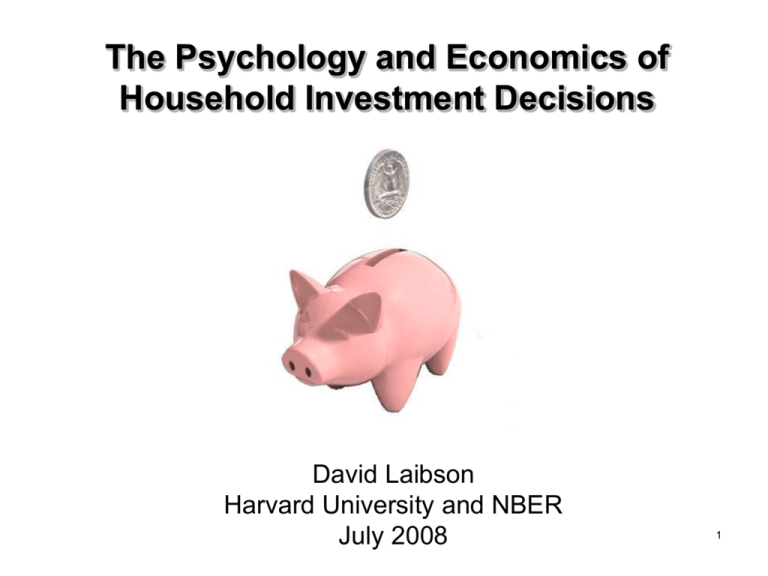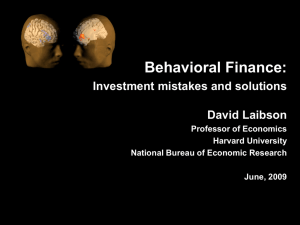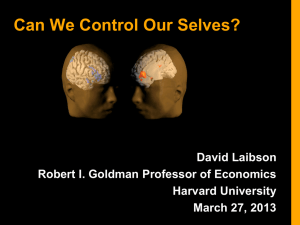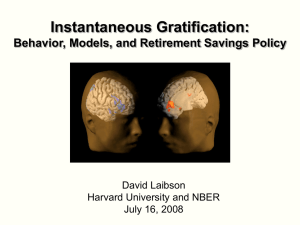PPT - Harvard University
advertisement

The Psychology and Economics of Household Investment Decisions David Laibson Harvard University and NBER July 2008 1 Should Defaults Influence Economic Outcomes? Standard neoclassical theory: If transactions costs are small and stakes are large, defaults should not influence rational consumers. In practice, defaults make an enormous difference: Organ donation (Johnson and Goldstein 2003) Car insurance Car purchase options Consent to receive e-mail marketing Savings Asset allocation US: Rising Role of DC Plans Private-Sector Workers Pension type (as a proportion of all pensioned workers) 70% 50% 30% 10% 1979 Only Only 1990 3 2004 Outline 1. 2. 3. Defaults affect all saving and asset allocation outcomes Four psychological factors jointly contribute to the default effect Alternative interventions are much less influential than defaults This morning’s lecture: facts quasi-positive, since some facts have a normative flavor This afternoon’s lecture: normative mechanism design 1. Defaults Affect Saving and Asset Allocation i. ii. iii. iv. v. Participation Contribution rates Asset allocation Pre-retirement distributions Decumulation / annuitization Participation, Contribution rates, and Asset Allocation Automatic Enrollment in a US 401(k) plan Welcome to the company If you don’t do anything… You are automatically enrolled in the 401(k) You save 2% of your pay Your contributions go into a money market fund Call this phone number to opt out of enrollment or change your investment allocations Fraction of employees ever participated Madrian and Shea (2001) Choi, Laibson, Madrian, Metrick (2004) 401(k) participation by tenure at firm 100% Hired during AE 80% 60% Hired before AE 40% Hired after AE ended 20% 0% 0 6 12 18 24 30 36 Tenure at company (months) Hired before automatic enrollment 42 48 Employees enrolled under auto-enrollment cluster at the default contribution rate. Fraction of participants Distribution of contribution rates 80% 70% 60% 50% 40% 30% 20% 10% 0% 67 Default contribution rate under automatic enrollment 37 31 26 20 9 6 3 18 17 14 7 14 6 1 1% 2% Hired before automatic enrollment Hired after automatic enrollment ended 3-5% 6% Contribution rate 7-10% 10 9 4 11-16% Hired during automatic enrollment (2% default) Participants stay at the automatic enrollment defaults for a long time. Fraction of participants Fraction of participants hired during auto-enrollment at both default contribution rate and asset allocation 100% 80% 60% 40% 20% 0% 0 6 12 18 24 30 36 Tenure at company (months) Company B Company C 42 Company D 48 Automatic enrollment: Conclusions Automatic enrollment dramatically increases 401(k) participation Participants hired under automatic enrollment tend to stay at the automatic enrollment defaults Similar default effects are observed for cash distributions at separation saving rates at match thresholds Auto-escalation and SMART (Benartzi and Thaler) Do workers “like” automatic enrollment? In firms with standard 401(k) plans (no auto-enrollment), 2/3 of workers say that they should save more Opt-out rates under automatic enrollment are typically only 15% (opt-out rates rarely exceed 20%) Under automatic enrollment employers report “no complaints” in 401(k) plans 97% of employees in auto-enrollment firms approve of autoenrollment. Even among workers who opt out of automatic enrollment, approval is 79%. Even the glacial US government is about to adopt automatic enrollment. 11 Additional evidence on Asset Allocation Private account component of Swedish Social Security system (Cronqvist and Thaler, 2004) At inception, one-third of assets are invested in the default fund Subsequent enrollees invest 90% of assets in the default fund Company match in employer stock (Choi, Laibson and Madrian, 2005b, 2007) The Flypaper Effect in Individual Investor Asset Allocation (Choi, Laibson, Madrian 2007) Studied a firm that used several different match systems in their 401(k) plan. I’ll discuss two of those regimes today: Match allocated to employer stock and workers can reallocate Call this “default” case (default is employer stock) Match allocated to an asset actively chosen by workers; workers required to make an active designation. Call this “no default” case (workers must choose) Economically, these two systems are identical. They both allow workers to do whatever the worker wants. Consequences of the two regimes Balances in employer stock Default ES No Default Own Balance in Employer Stock 24% 20% Matching Balance in Employer Stock 94% 27% Total Balance in Employer Stock 56% 22% 14 Cash Distributions What happens to savings plan balances when employees leave their jobs? Employees can request a cash distribution or roll balances over into another account Balances >$5000: default leaves balances with former employer Balances <$5000: default distributes balances as cash transfer Vast majority of employees accept default (Choi et al. 2002, 2004a and 2004b) When employees receive small cash distributions, balances typically consumed (Poterba, Venti and Wise 1998) Post-Retirement Distributions Social Security Defined benefit pension Joint and survivor annuity (reduced benefits) Annuity Lump sum payout if offered Defined contribution savings plan Lump sum payout Annuity if offered Defined Benefit Pension Annuitization Annuity income and economic welfare of the elderly Social Security replacement rate relatively low on average 17% of women fall into poverty after the death of their spouse (Holden and Zick 2000) For married individuals, three distinct annuitization regimes Pre-1974: no regulation ERISA I (1974): default joint-and-survivor annuity with option to opt-out ERISA II (1984 amendment): default joint-and-survivor annuity, opting out required notarized permission of spouse Defined Benefit Pension Annuitization Effect of joint-and-survivor default on annuitization Pre-1974: Less than half of married men have joint-and-survivor annuity Post-ERISA (I + II): joint-and-survivor annuitization increases 25 percentage points (Holden and Nicholson 1998) Post-1984 amendments: joint-and-survivor annuitization increases 5 to 10 percentage points (Saku 2001) Four psychological factors contribute to the default effect i. ii. iii. iv. Financial illiteracy Endorsement Complexity Present-bias i. Financial illiteracy John Hancock Financial Services Defined Contribution Plan Survey (2002) 38% of respondents report that they have little or no financial knowledge 40% of respondents believe that a money market fund contains stocks Two-thirds of respondents don’t know that it is possible to lose money in government bonds Respondents on average believe that employer stock is less risky than a stock mutual fund Two-thirds report that they would be better off working with an investment advisor than managing investments solo Financial illiteracy among Wharton MBA’s Choi, Laibson, Madrian (2006) Subjects allocate $10,000 among four funds Randomly choose two subjects to receive any positive portfolio return during the subsequent year Eliminate variation in pre-fee returns Choose among S&P 500 index funds Unbundle services from returns Experimenters pay out portfolio returns, so no access to investment company services One year of index fund fees on a $10,000 investment $700 $600 $64 $80 $500 $400 $300 Expense ratio Load $59 $475 $525 $70 $200 $100 $250 $250 $0 Allegiant Mason Street Morgan Stanley UBS Experimental conditions Control Fees transparency treatment Subjects receive only four prospectuses Prospectuses are often the only information investors receive from companies Eliminate search costs by also distributing fee summary sheet (repeats information in prospectus) Returns treatment Highlight extraneous information by distributing summary of funds’ annualized returns since inception (repeats information in prospectus) Fees paid by control groups (prospectus only) Maximum Possible Fee $589 $549 $509 $469 $429 $443: average fee with random fund allocation $421 $431 Control $389 $349 Minimum Possible Fee $309 t-test: p=0.5086 N = 83 MBA 6% of MBA Controls put all funds in minimum-fee fund N = 30 College 0% of College Controls put all funds in minimum-fee fund Ranking of factor importance MBA controls 1. Fees 2. 1-year performance 3. Performance since inception 4. Investment objectives 5. Desire to diversify among funds 6. Brand recognition 7. Performance over different horizon 8. Past experience with fund companies 9. Quality of prospectus 10. Customer service of fund 11. Minimum opening balance College controls 1. 1-year performance 2. Performance since inception 3. Desire to diversify among funds 4. Investment objectives 5. Quality of prospectus 6. Performance over different horizon 7. Brand recognition 8. Fees 9. Customer service of fund 10. Minimum opening balance 11. Past experience with fund companies Effect of fee treatment (prospectus plus 1-page sheet highlighting fees) $589 $549 $509 $469 $429 $431 $421 $389 Control Fee treatment $410 $366** $349 $309 t-tests: MBA: p=0.0000 College: p=0.1451 N = 83 N = 85 N = 30 N = 29 MBA College 19% of MBA treatment put all 10% of College treatment put funds in minimum-fee fund all funds in minimum-fee fund Ranking of factor importance MBA fee treatment 1. Fees 2. 1-year performance 3. Performance since inception College fee treatment 1. Fees 2. 1-year performance 3. Performance since inception MBA controls 1. Fees 2. 1-year performance 3. Performance since inception College controls 1. 1-year performance 2. Performance since inception 3. Desire to diversify among funds Lack of confidence and fees How likely is it you would change your decision if you consulted a professional investment advisor? $589 $549 Fee $509 $469 $429 $453 $435 $424 $409 $395 $389* $389 $349 $309 N = 64 N = 136 N = 50 MBA t-tests: MBA 1 vs. 2, p=0.2013; MBA 1 vs. 3, p=0.0479; College 1 vs. 2, p=0.2864; College 1 vs. 3, p=0.3335 N = 46 N = 36 N=5 College Very likely Somewhat likely Not at all likely We conducted a similar experiment with Harvard staff as subjects In this new version we have 400 subjects (administrators, faculty assistants, technical personal, but not faculty) We give every one of our subjects $10,000 and rewarded them with any gains on their investment $4,000,000 short position in stock market 32 Data from Harvard Staff $581 $516 $451 $385 $320 $255 Control Treatment Fee Treatment $518 $494 3% of Harvard staff 9% of Harvard staff in Fee Treatment in Control Treatment put all $$$ put all $$$ in low-cost fund in low-cost fund Fees from random allocation $431 33 ii. Endorsement A non-zero default is perceived as advice Evidence Elective employer stock allocation in firms that do and do not match in employer stock (Benartzi 2001, Holden and Vanderhei 2001, and Brown, Liang and Weisbenner 2006) Asset allocation of employees hired before automatic enrollment (Choi, Laibson, Madrian 2006) Choi, Laibson, and Madrian (2007) Asset Allocation Outcomes of Employees Who are Not Subject to Automatic Enrollment Any balances in default fund All balances in default fund 13% 2% Company D Hired before, participated before AE Choi, Laibson, and Madrian (2007) Asset Allocation Outcomes of Employees Who are Not Subject to Automatic Enrollment Any balances in default fund All balances in default fund Hired before, participated before AE 13% 2% Hired before, participated after AE 29% 16% Company D iii. Complexity Complexity delay Psychology literature (Tversky and Shafir 1992, Shafir, Simonson and Tversky 1993, Dhar and Knowlis 1999, Iyengar and Lepper 2000 ) Savings literature: each additional 10 funds produces a 1.5 to 2.0 percentage point decline in participation (Iyengar, Huberman and Jiang 2004) Also results on complexity generating more conservative asset allocation (Iyengar and Kamenica 2007). Quick enrollment experiments Complexity and Quick Enrollment Conceptual Idea Implementation at Company D Simplify the savings plan enrollment decision by giving employees an easy way to elect a pre-selected contribution rate and asset allocation bundle New hires at employee orientation: 2% contribution rate invested 50% money market & 50% stable value Implementation at Company E Existing non-participants: 3% contribution rate invested 100% in money market fund Fraction Participating in Savings Plan Quick Enrollment and Savings Plan Participation 50% 40% After Quick Enrollment 34% 30% 20% 10% Before Quick Enrollment 9% After Quick Enrollment 16% Before Quick Enrollment 6% 0% Company D: 4 months after baseline Company E: 4 months after baseline Simplified enrollment raises participation Fraction Ever Participating in Plan Beshears, Choi, Laibson, Madrian (2006) 50% 2005 2004 40% 30% 2003 20% 10% 0% 0 3 6 9 12 15 18 21 24 27 30 33 Time since baseline (months) 43 iv. Present-Biased Preferences Self control problems undermine good savings intentions Why do today what you can put off until tomorrow Strotz (1957), Phelps and Pollak (1968), Akerlof (1991), Laibson (1997), O’Donoghue and Rabin (1999), Diamond and Koszegi (2003) Formal Model Quasi-hyperbolic discounting Phelps and Pollak 1968, Laibson 1997 D(t) = 1, bd, bd2, bd3, ... Ut = ut + bdut+1 + bd2ut+2 + bd3ut+3 + ... Ut = ut + b [dut+1 + d2ut+2 + d3ut+3 + ...] b uniformly discounts all future periods. d exponentially discounts all future periods. Short-run rate of decline is approximately 1 – bd. Long-run rate of decline is approximately 1- d. 45 Building intuition To build intuition, assume that b = ½ and d = 1. Discounted utility function becomes Ut = ut + ½ [ut+1 + ut+2 + ut+3 + ...] Discounted utility from the perspective of time t+1. Ut+1 = ut+1 + ½ [ut+2 + ut+3 + ...] Discount function reflects dynamic inconsistency: preferences held at date t do not agree with preferences held at date t+1. 46 Procrastination Akerlof 1991, O’Donoghue and Rabin 1999 Assume that b = ½ and d = 1. Suppose exercise (cost 6) generates delayed benefits (value 8). When will you exercise? Exercise Today: Exercise Tomorrow: -6 + ½ [8] = -2 0 + ½ [-6 + 8] = 1 Agent would like to make plans today to exercise tomorrow. Agent won’t follow through without commitment. 47 Beliefs about the future? Sophisticates: know that their plans to be patient tomorrow won’t pan out (Strotz, 1957). “I won’t quit smoking next week, though I would like to do so.” Naifs: mistakenly believe that their plans to be patient will be perfectly carried out (Strotz, 1957). Think that β=1 in the future. “I will quit smoking next week, though I’ve failed to do so every week for five years.” Partial naifs: mistakenly believe that β=β* in the future where β < β* < 1 (O’Donoghue and Rabin, 2001). 48 Naifs vs. sophisticates Continue to analyze the earlier exercise example. How often would a naif exercise? How often would a naif predict she would exercise? How often would a sophisticate exercise? How often would a sophisticate predict she would exercise? Would a sophisticate join a gym? What else would a sophisticate do? 49 Self-regulation Ariely and Wertenbroch (2002) Three proofreading tasks: "Sexual identity is intrinsically impossible," says Foucault; however, according to de Selby[1], it is not so much sexual identity that is intrinsically impossible, but rather the dialectic, and some would say the satsis, of sexual identity. Thus, D'Erlette[2] holds that we have to choose between premodern dialectic theory and subcultural feminism imputing the role of the observer as poet. Evenly spaced deadlines. [$20 earnings] Self-imposed deadlines --- subjects in this condition could adopt costly deadlines ($1/day) and most did so. [$13 earnings] End deadline. [$5 earnings] 50 A formal model of procrastination Doing a job costs c units of effort in current period. Each period c is drawn from a uniform distribution on [0,1]. Until job is done, agent losses θ units per period. Suppose δ = 1. Timing: 1. Pay delay cost θ 2. Realize current value of c (drawn from uniform) 3. Decide whether or not to do the task at current cost c 4. If task is not done, period ends and return to step 1. 51 Sophisticated procrastination There are many equilibria of this game. Let’s study the equilibrium in which sophisticates act whenever c < c*. We need to solve for c*. This is sometimes called the action threshold. Let V represent the expected undiscounted cost of waiting (until at least the next period): V = θ + (c*)(c*/2) + (1- c*)V In equilibrium, the sophisticate needs to be exactly indifferent between acting now and waiting. c* = βV = β[θ + (c*)(c*/2) + (1- c*)V] Solving for c*, we find: c* = [θ/(1/β -1/2)]1/2 52 So expected delay is 1/ c* = [(1/β -1/2)/θ]1/2 Naive procrastination There is a unique equilibrium of this game. Act whenever c < cN*. We need to solve for cN*. This is sometimes called the action threshold. Let cN** represent the expected future action threshold of the naïve agent. Let V represent the (naively) expected undiscounted cost of waiting (until at least the next period): V = θ + (cN**)(cN**/2) + (1- cN**)V (from last slide) cN** = (2θ)1/2 (from last slide w/ β=1) V = (2θ)1/2 (substituting for cN**) In equilibrium, the naive action threshold is given by cN* = βV = β(2θ)1/2 So average delay is 1/cN* = 1/β[1/(2θ)]1/2 > [(1/β -1/2)/θ]1/2 53 Illustrative Application without stochastics (assume b = ½ , d = 1). Suppose you can join the plan today (effort cost $50) to gain delayed benefits $20,000 (e.g. value of match) Every period you delay, total benefits fall by $10. What are the discounted costs of joining at different periods? Join Today: Join t+1: Join t+2: Join t+3: 50 0 0 0 + + + + ½ [0] ½ [50 + 10] ½ [50 + 20] ½ [50 + 30] = 50 = 30 = 35 = 40 Interaction with financial illiteracy Consider someone with a high level of financial literacy, so effort cost is only $10 (not $50) As before, every period of delay, total benefits fall by $10. What are the discounted costs of joining at different periods? Join Today: Join t+1: Join t+2: Join t+3: 10 0 0 0 + + + + ½ [0] ½ [10 + 10] ½ [10 + 20] ½ [10 + 30] = 10 = 10 = 15 = 20 58 Interaction with endorsement and complexity Consider a plan with a simple form, or an endorsed form, so the effort cost is again only $10 (not $50) As before, every period of delay, total benefits fall by $10. What are the discounted costs of joining at different periods? Join Today: Join t+1: Join t+2: Join t+3: 10 0 0 0 + + + + ½ [0] ½ [10 + 10] ½ [10 + 20] ½ [10 + 30] = 10 = 10 = 15 = 20 59 4. Alternative Policies Paying employees to save Educating employees $100 bills on the sidewalk Choi, Laibson, Madrian (2004) Employer match is an instantaneous, riskless return on investment Particularly appealing if you are over 59½ years old Have the most experience, so should be savvy Retirement is close, so should be thinking about saving Can withdraw money from 401(k) without penalty We study seven companies and find that on average, half of employees over 59½ years old are not fully exploiting their employer match Average loss is 1.6% of salary per year Educational intervention has no effect Financial education Choi, Laibson, Madrian, Metrick (2004) Seminars presented by professional financial advisors Curriculum: Setting savings goals, asset allocation, managing credit and debt, insurance against financial risks Seminars offered throughout 2000 Linked data on individual employees’ seminar attendance to administrative data on actual savings behavior before and after seminar Effect of education is positive but small Seminar attendees Non-attendees % planning to make change % actually made change % actually made change 100% 14% 7% Increase contribution rate 28% 8% 5% Change fund selection 47% 15% 10% Change asset allocation 36% 10% 6% Those not in 401(k) Enroll in 401(k) Plan Those already in 401(k) Effect of education is positive but small Seminar attendees Non-attendees % planning to make change % actually made change % actually made change 100% 14% 7% Increase contribution rate 28% 8% 5% Change fund selection 47% 15% 10% Change asset allocation 36% 10% 6% Those not in 401(k) Enroll in 401(k) Plan Those already in 401(k) 65 Effect of education is positive but small Seminar attendees Non-attendees % planning to make change % actually made change % actually made change 100% 14% 7% Increase contribution rate 28% 8% 5% Change fund selection 47% 15% 10% Change asset allocation 36% 10% 6% Those not in 401(k) Enroll in 401(k) Plan Those already in 401(k) 66 • Financial education effects are small • Seminar attendees have good intentions to change their 401(k) savings behavior, but most do not follow through • Financial education alone will not dramatically improve the quality of 401(k) savings outcomes • Choi et al (2005) study the effect of the Enron, Worldcom, and Global Crossing scandals on employer stock holding • No net sales of employer stock in reaction to these news stories • These scandals did not affect the asset allocation decisions of new hires. • These hires did not affect the asset allocation decisions of new hires at other Houston firms. Conclusion Defaults are not neutral for four key reasons: Investors are not financially literate Investors display an endorsement effect Investors respond adversely to complexity Investors are prone to procrastinate There may be other reasons: loss aversion? Employers/institutions will influence savings outcomes through the choice of defaults (whether the institution wants to do this or not) We should devote considerable effort to the analysis of how we pick defaults. END HERE 69 3. Optimal Defaults – public policy Mechanism design problem in which policy makers set a default for agents with present bias (Carrol, Choi, Laibson, Madrian and Metrick 2007) Defaults are sticky for three reasons Cost of opting-out of the default Cost varies over time option value of waiting Present-biased preferences procrastination 70 Basic set-up of problem Specify behavioral model of households Flow cost of staying at the default Effort cost of opting-out of the default Effort cost varies over time option value of waiting to leave the default Present-biased preferences procrastination Specify (dynamically consistent) social welfare function of planner (e.g., set β=1) Planner picks default to optimize social welfare function 71 Optimal ‘Defaults’ Two classes of optimal defaults Automatic enrollment Optimal when employees have relatively homogeneous savings preferences (e.g. match threshold) and relatively little propensity to procrastinate “Active Decision” — require individuals to make a decision (eliminate the option to passively accept a default) Optimal when employees have relatively heterogeneous savings preferences and relatively strong tendency to procrastinate Key point: sometimes the best default is no default. 72 High Heterogeneity 30% Offset Default Low Heterogeneity Active Decision Center Default 0% 0 Beta 1 Lessons from theoretical analysis of defaults Defaults should be set to maximize average wellbeing, which is not the same as saying that the default should be equal to the average preference. Endogenous opting out should be taken into account when calculating the optimal default. The default has two roles: causing some people to opt out of the default (which generates costs and benefits) implicitly setting savings policies for everyone who sticks with the default 74 The power of deadlines: Active decisions Choi, Laibson, Madrian, Metrick (2007) Active decision mechanisms require employees to make an active choice about 401(k) participation. Welcome to the company You are required to submit this form within 30 days of hire, regardless of your 401(k) participation choice If you don’t want to participate, indicate that decision If you want to participate, indicate your contribution rate and asset allocation Being passive is not an option 75 401(k) participation by tenure Fraction of employees ever participated 100% 80% 60% 40% 20% 0% 0 6 12 18 24 30 36 42 Tenure at company (months) Active decision cohort 48 Standard enrollment cohort 54 76 Active decisions: conclusions Active decision raises 401(k) participation. Active decision raises average savings rate by 50 percent. Active decision doesn’t induce choice clustering. Under active decision, employees choose savings rates that they otherwise would have taken three years to achieve. (Average level as well as the entire multivariate covariance structure.) 77 New directions for defaults Defaults for savings rate escalation Defaults with high savings rates Defaults for lifecycle rebalancing Defaults for annual rebalancing Defaults for employer stock Defaults at separation Defaults for annuitization Individualized defaults (savings rate and asset allocation) Defaults for employees not covered by DB/DC plans Defaults for investment of tax refunds 78





